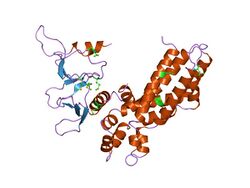Biology:RhoGEF domain
| DH/PH RhoGEF domain | |||||||||||
|---|---|---|---|---|---|---|---|---|---|---|---|
 Structure of the RhoGEF domain from the human Son of sevenless protein, an example of a DH/PH domain RhoGEF.[1] | |||||||||||
| Identifiers | |||||||||||
| Symbol | RhoGEF | ||||||||||
| Pfam | PF00621 | ||||||||||
| InterPro | IPR035899 IPR000219, IPR035899 | ||||||||||
| SMART | RhoGEF | ||||||||||
| SCOP2 | 1dbh / SCOPe / SUPFAM | ||||||||||
| OPM protein | 1xd4 | ||||||||||
| CDD | cd00160 | ||||||||||
| |||||||||||
| Dedicator of cytokinesis (DOCK) RhoGEF domain | |||||||||||
|---|---|---|---|---|---|---|---|---|---|---|---|
| Identifiers | |||||||||||
| Symbol | RhoGEF | ||||||||||
| Pfam | PF06920 | ||||||||||
| InterPro | IPR010703 IPR026791, IPR010703 | ||||||||||
| SCOP2 | 1wg7 / SCOPe / SUPFAM | ||||||||||
| CDD | cd11684 | ||||||||||
| |||||||||||
RhoGEF domain describes two distinct structural domains with guanine nucleotide exchange factor (GEF) activity to regulate small GTPases in the Rho family. Rho small GTPases are inactive when bound to GDP but active when bound to GTP; RhoGEF domains in proteins are able to promote GDP release and GTP binding to activate specific Rho family members, including RhoA, Rac1 and Cdc42.
The largest class of RhoGEFs is composed of proteins containing the "Dbl-homology" (DH) domain, which almost always is found together with a pleckstrin-homology (PH) domain to form a combined DH/PH domain structure.[2][3]
A distinct class of RhoGEFs is those proteins containing the DOCK/CZH/DHR-2 domain. This structure has no sequence similarity with DBL-homology domains.[4]
Human proteins containing DH/PH RhoGEF domain
ABR; AKAP13/ARHGEF13/Lbc; ALS2; ALS2CL; ARHGEF1/p115-RhoGEF; ARHGEF10; ARHGEF10L; ARHGEF11/PDZ-RhoGEF.; ARHGEF12/LARG; ARHGEF15; ARHGEF16; ARHGEF17; ARHGEF18; ARHGEF19; ARHGEF2; ARHGEF25; ARHGEF26; ARHGEF28; ARHGEF3; ARHGEF33; ARHGEF35; ARHGEF37; ARHGEF38; ARHGEF39; ARHGEF4; ARHGEF40; ARHGEF5; ARHGEF6/alpha-PIX; ARHGEF7/beta-PIX; ARHGEF9; BCR; DNMBP; ECT2; ECT2L; FARP1; FARP2; FGD1; FGD2; FGD3; FGD4; FGD5; FGD6; ITSN1/Intersectin 1; ITSN2/Intersectin 2; KALRN/Kalirin; MCF2; MCF2L; MCF2L2; NET1; NGEF; OBSCN; PLEKHG1; PLEKHG2; PLEKHG3; PLEKHG4; PLEKHG4B; PLEKHG5; PLEKHG6; PREX1; PREX2; RASGRF1; RASGRF2; SPATA13; TIAM1; TIAM2; TRIO; VAV1; VAV2; VAV3.
Human proteins containing DOCK/CZH RhoGEF domain
DOCK1/DOCK180; DOCK2; DOCK3/MOCA; DOCK4; DOCK5; DOCK6/ZIR1; DOCK7/ZIR2; DOCK8/ZIR3; DOCK9/Zizimin1; DOCK10/Zizimin2; DOCK11/Zizimin3
See also
- GTPase
- Small GTPase
- Guanine nucleotide exchange factor
- Rho family of GTPases
References
- ↑ "Crystal structure of the Dbl and pleckstrin homology domains from the human Son of sevenless protein". Cell 95 (2): 259–68. October 1998. doi:10.1016/S0092-8674(00)81756-0. PMID 9790532.
- ↑ "The Evolutionary Landscape of Dbl-Like RhoGEF Families: Adapting Eukaryotic Cells to Environmental Signals". Genome Biology and Evolution 9 (6): 1471–1486. June 2017. doi:10.1093/gbe/evx100. PMID 28541439.
- ↑ "The Dbl family of oncogenes". Current Opinion in Cell Biology 8 (2): 216–22. April 1996. doi:10.1016/s0955-0674(96)80068-8. PMID 8791419.
- ↑ "Identification of an evolutionarily conserved superfamily of DOCK180-related proteins with guanine nucleotide exchange activity". Journal of Cell Science 115 (Pt 24): 4901–13. December 2002. doi:10.1242/jcs.00219. PMID 12432077.
Further reading
- "Catalysis of guanine nucleotide exchange on the CDC42Hs protein by the dbl oncogene product". Nature 354 (6351): 311–4. November 1991. doi:10.1038/354311a0. PMID 1956381.
- "The human active breakpoint cluster region-related gene encodes a brain protein with homology to guanine nucleotide exchange proteins and GTPase-activating proteins". The Journal of Biological Chemistry 268 (36): 27291–8. December 1993. doi:10.1016/S0021-9258(19)74248-3. PMID 8262969.
- "Crystal structure of the Dbl and pleckstrin homology domains from the human Son of sevenless protein". Cell 95 (2): 259–68. October 1998. doi:10.1016/S0092-8674(00)81756-0. PMID 9790532.
 |

